Users of Financial Information and Accounting Concepts
VerifiedAdded on 2023/01/09
|8
|1992
|45
AI Summary
This coursework discusses the main users of financial information, including employees, managers, investors, lenders, and the government. It also explains important accounting concepts such as the prudence concept, dual accounting principle, business entity concept, matching concept, and money measurement concept. The coursework provides insights into the importance of financial information for decision-making and compliance with accounting standards and regulations.
Contribute Materials
Your contribution can guide someone’s learning journey. Share your
documents today.

Accounting Coursework
Questions
Questions
Secure Best Marks with AI Grader
Need help grading? Try our AI Grader for instant feedback on your assignments.

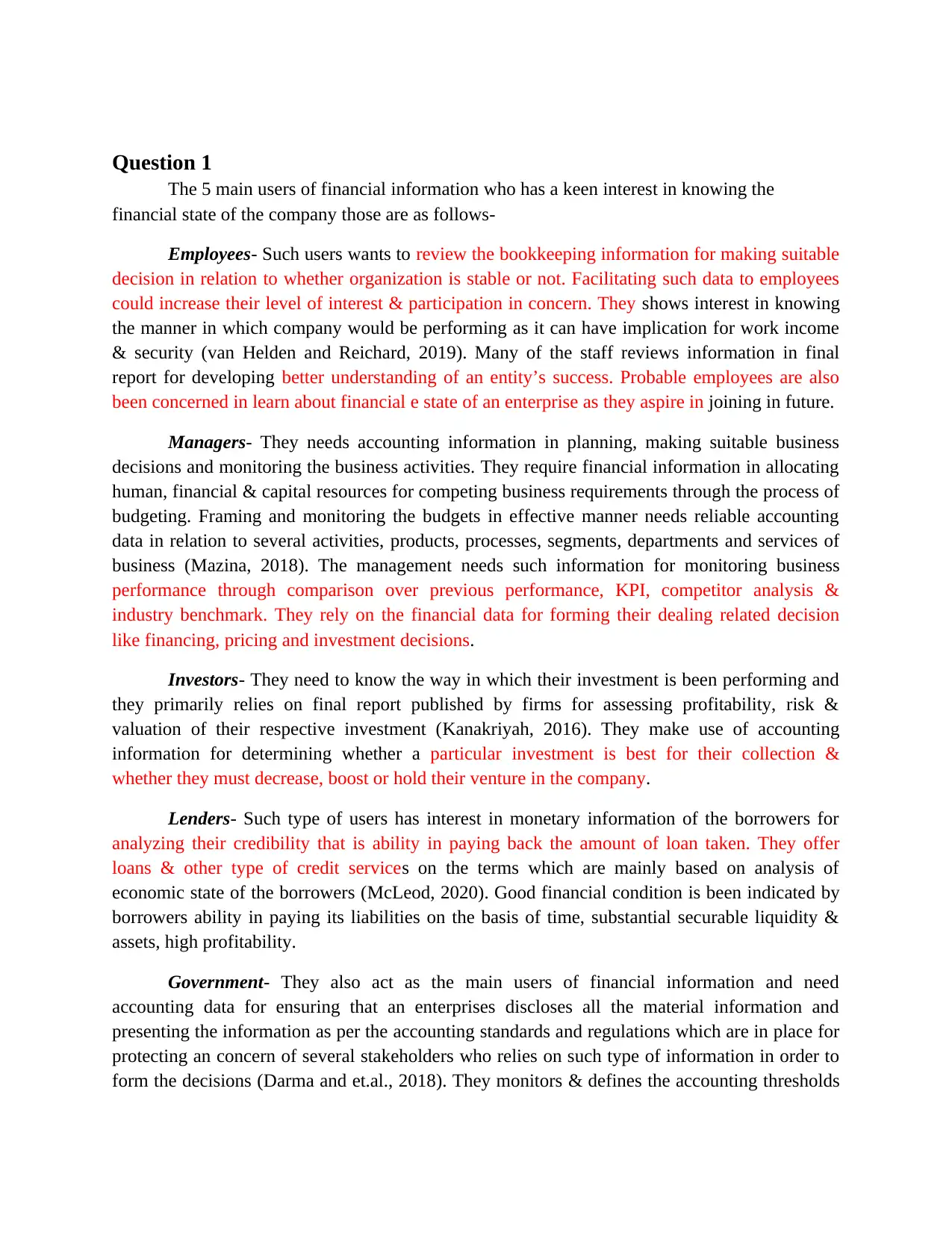
Question 1
The 5 main users of financial information who has a keen interest in knowing the
financial state of the company those are as follows-
Employees- Such users wants to review the bookkeeping information for making suitable
decision in relation to whether organization is stable or not. Facilitating such data to employees
could increase their level of interest & participation in concern. They shows interest in knowing
the manner in which company would be performing as it can have implication for work income
& security (van Helden and Reichard, 2019). Many of the staff reviews information in final
report for developing better understanding of an entity’s success. Probable employees are also
been concerned in learn about financial e state of an enterprise as they aspire in joining in future.
Managers- They needs accounting information in planning, making suitable business
decisions and monitoring the business activities. They require financial information in allocating
human, financial & capital resources for competing business requirements through the process of
budgeting. Framing and monitoring the budgets in effective manner needs reliable accounting
data in relation to several activities, products, processes, segments, departments and services of
business (Mazina, 2018). The management needs such information for monitoring business
performance through comparison over previous performance, KPI, competitor analysis &
industry benchmark. They rely on the financial data for forming their dealing related decision
like financing, pricing and investment decisions.
Investors- They need to know the way in which their investment is been performing and
they primarily relies on final report published by firms for assessing profitability, risk &
valuation of their respective investment (Kanakriyah, 2016). They make use of accounting
information for determining whether a particular investment is best for their collection &
whether they must decrease, boost or hold their venture in the company.
Lenders- Such type of users has interest in monetary information of the borrowers for
analyzing their credibility that is ability in paying back the amount of loan taken. They offer
loans & other type of credit services on the terms which are mainly based on analysis of
economic state of the borrowers (McLeod, 2020). Good financial condition is been indicated by
borrowers ability in paying its liabilities on the basis of time, substantial securable liquidity &
assets, high profitability.
Government- They also act as the main users of financial information and need
accounting data for ensuring that an enterprises discloses all the material information and
presenting the information as per the accounting standards and regulations which are in place for
protecting an concern of several stakeholders who relies on such type of information in order to
form the decisions (Darma and et.al., 2018). They monitors & defines the accounting thresholds
The 5 main users of financial information who has a keen interest in knowing the
financial state of the company those are as follows-
Employees- Such users wants to review the bookkeeping information for making suitable
decision in relation to whether organization is stable or not. Facilitating such data to employees
could increase their level of interest & participation in concern. They shows interest in knowing
the manner in which company would be performing as it can have implication for work income
& security (van Helden and Reichard, 2019). Many of the staff reviews information in final
report for developing better understanding of an entity’s success. Probable employees are also
been concerned in learn about financial e state of an enterprise as they aspire in joining in future.
Managers- They needs accounting information in planning, making suitable business
decisions and monitoring the business activities. They require financial information in allocating
human, financial & capital resources for competing business requirements through the process of
budgeting. Framing and monitoring the budgets in effective manner needs reliable accounting
data in relation to several activities, products, processes, segments, departments and services of
business (Mazina, 2018). The management needs such information for monitoring business
performance through comparison over previous performance, KPI, competitor analysis &
industry benchmark. They rely on the financial data for forming their dealing related decision
like financing, pricing and investment decisions.
Investors- They need to know the way in which their investment is been performing and
they primarily relies on final report published by firms for assessing profitability, risk &
valuation of their respective investment (Kanakriyah, 2016). They make use of accounting
information for determining whether a particular investment is best for their collection &
whether they must decrease, boost or hold their venture in the company.
Lenders- Such type of users has interest in monetary information of the borrowers for
analyzing their credibility that is ability in paying back the amount of loan taken. They offer
loans & other type of credit services on the terms which are mainly based on analysis of
economic state of the borrowers (McLeod, 2020). Good financial condition is been indicated by
borrowers ability in paying its liabilities on the basis of time, substantial securable liquidity &
assets, high profitability.
Government- They also act as the main users of financial information and need
accounting data for ensuring that an enterprises discloses all the material information and
presenting the information as per the accounting standards and regulations which are in place for
protecting an concern of several stakeholders who relies on such type of information in order to
form the decisions (Darma and et.al., 2018). They monitors & defines the accounting thresholds
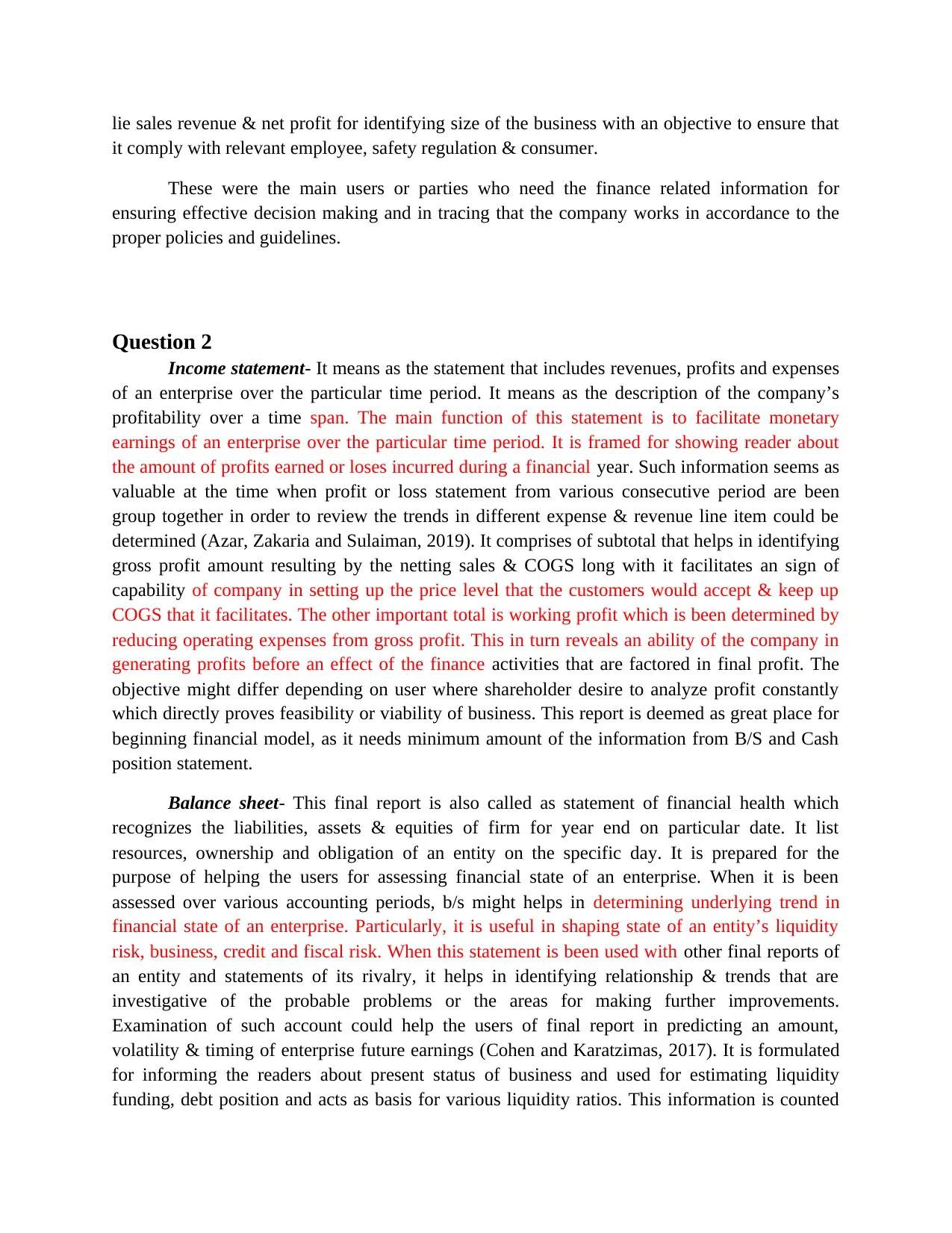
lie sales revenue & net profit for identifying size of the business with an objective to ensure that
it comply with relevant employee, safety regulation & consumer.
These were the main users or parties who need the finance related information for
ensuring effective decision making and in tracing that the company works in accordance to the
proper policies and guidelines.
Question 2
Income statement- It means as the statement that includes revenues, profits and expenses
of an enterprise over the particular time period. It means as the description of the company’s
profitability over a time span. The main function of this statement is to facilitate monetary
earnings of an enterprise over the particular time period. It is framed for showing reader about
the amount of profits earned or loses incurred during a financial year. Such information seems as
valuable at the time when profit or loss statement from various consecutive period are been
group together in order to review the trends in different expense & revenue line item could be
determined (Azar, Zakaria and Sulaiman, 2019). It comprises of subtotal that helps in identifying
gross profit amount resulting by the netting sales & COGS long with it facilitates an sign of
capability of company in setting up the price level that the customers would accept & keep up
COGS that it facilitates. The other important total is working profit which is been determined by
reducing operating expenses from gross profit. This in turn reveals an ability of the company in
generating profits before an effect of the finance activities that are factored in final profit. The
objective might differ depending on user where shareholder desire to analyze profit constantly
which directly proves feasibility or viability of business. This report is deemed as great place for
beginning financial model, as it needs minimum amount of the information from B/S and Cash
position statement.
Balance sheet- This final report is also called as statement of financial health which
recognizes the liabilities, assets & equities of firm for year end on particular date. It list
resources, ownership and obligation of an entity on the specific day. It is prepared for the
purpose of helping the users for assessing financial state of an enterprise. When it is been
assessed over various accounting periods, b/s might helps in determining underlying trend in
financial state of an enterprise. Particularly, it is useful in shaping state of an entity’s liquidity
risk, business, credit and fiscal risk. When this statement is been used with other final reports of
an entity and statements of its rivalry, it helps in identifying relationship & trends that are
investigative of the probable problems or the areas for making further improvements.
Examination of such account could help the users of final report in predicting an amount,
volatility & timing of enterprise future earnings (Cohen and Karatzimas, 2017). It is formulated
for informing the readers about present status of business and used for estimating liquidity
funding, debt position and acts as basis for various liquidity ratios. This information is counted
it comply with relevant employee, safety regulation & consumer.
These were the main users or parties who need the finance related information for
ensuring effective decision making and in tracing that the company works in accordance to the
proper policies and guidelines.
Question 2
Income statement- It means as the statement that includes revenues, profits and expenses
of an enterprise over the particular time period. It means as the description of the company’s
profitability over a time span. The main function of this statement is to facilitate monetary
earnings of an enterprise over the particular time period. It is framed for showing reader about
the amount of profits earned or loses incurred during a financial year. Such information seems as
valuable at the time when profit or loss statement from various consecutive period are been
group together in order to review the trends in different expense & revenue line item could be
determined (Azar, Zakaria and Sulaiman, 2019). It comprises of subtotal that helps in identifying
gross profit amount resulting by the netting sales & COGS long with it facilitates an sign of
capability of company in setting up the price level that the customers would accept & keep up
COGS that it facilitates. The other important total is working profit which is been determined by
reducing operating expenses from gross profit. This in turn reveals an ability of the company in
generating profits before an effect of the finance activities that are factored in final profit. The
objective might differ depending on user where shareholder desire to analyze profit constantly
which directly proves feasibility or viability of business. This report is deemed as great place for
beginning financial model, as it needs minimum amount of the information from B/S and Cash
position statement.
Balance sheet- This final report is also called as statement of financial health which
recognizes the liabilities, assets & equities of firm for year end on particular date. It list
resources, ownership and obligation of an entity on the specific day. It is prepared for the
purpose of helping the users for assessing financial state of an enterprise. When it is been
assessed over various accounting periods, b/s might helps in determining underlying trend in
financial state of an enterprise. Particularly, it is useful in shaping state of an entity’s liquidity
risk, business, credit and fiscal risk. When this statement is been used with other final reports of
an entity and statements of its rivalry, it helps in identifying relationship & trends that are
investigative of the probable problems or the areas for making further improvements.
Examination of such account could help the users of final report in predicting an amount,
volatility & timing of enterprise future earnings (Cohen and Karatzimas, 2017). It is formulated
for informing the readers about present status of business and used for estimating liquidity
funding, debt position and acts as basis for various liquidity ratios. This information is counted
Secure Best Marks with AI Grader
Need help grading? Try our AI Grader for instant feedback on your assignments.
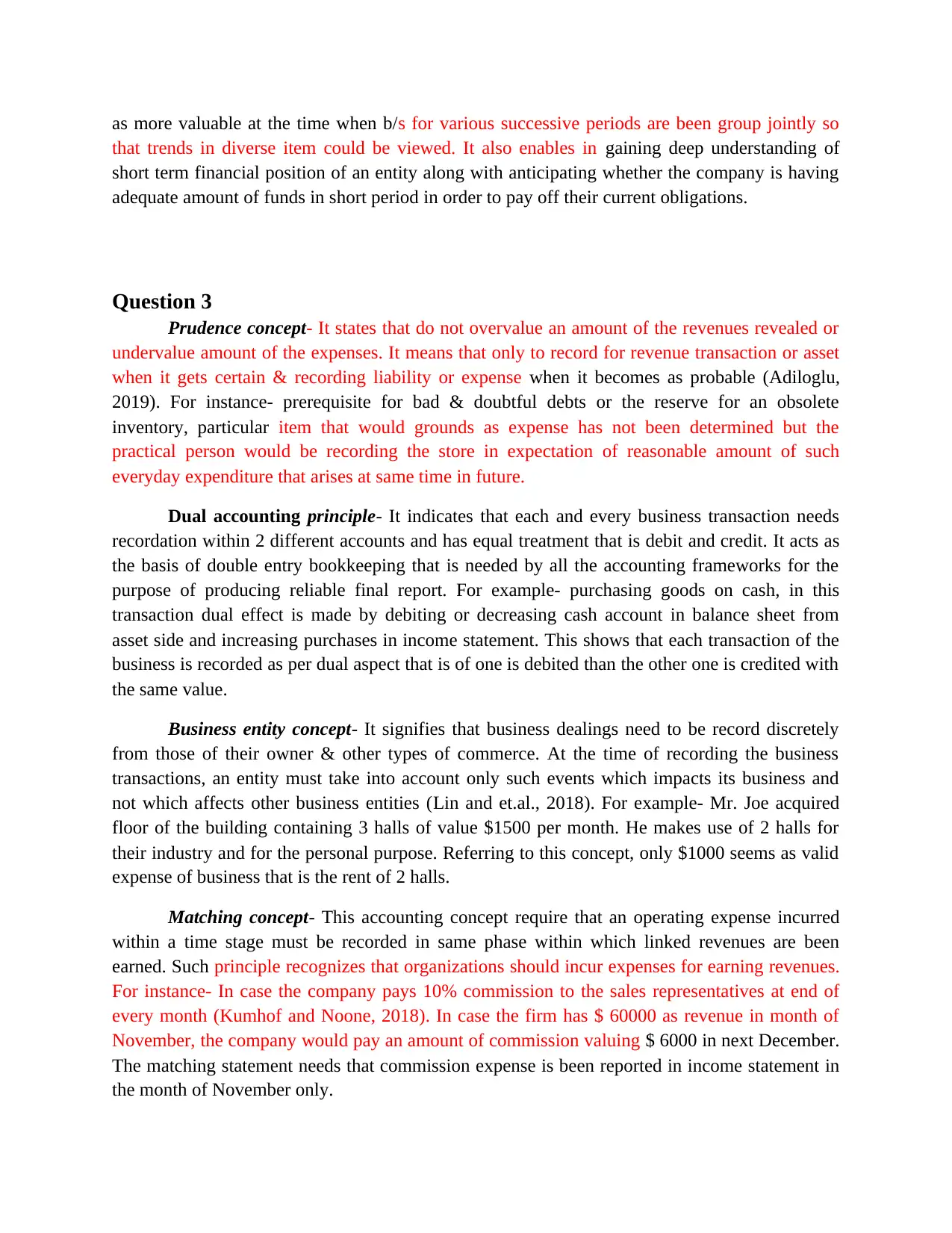
as more valuable at the time when b/s for various successive periods are been group jointly so
that trends in diverse item could be viewed. It also enables in gaining deep understanding of
short term financial position of an entity along with anticipating whether the company is having
adequate amount of funds in short period in order to pay off their current obligations.
Question 3
Prudence concept- It states that do not overvalue an amount of the revenues revealed or
undervalue amount of the expenses. It means that only to record for revenue transaction or asset
when it gets certain & recording liability or expense when it becomes as probable (Adiloglu,
2019). For instance- prerequisite for bad & doubtful debts or the reserve for an obsolete
inventory, particular item that would grounds as expense has not been determined but the
practical person would be recording the store in expectation of reasonable amount of such
everyday expenditure that arises at same time in future.
Dual accounting principle- It indicates that each and every business transaction needs
recordation within 2 different accounts and has equal treatment that is debit and credit. It acts as
the basis of double entry bookkeeping that is needed by all the accounting frameworks for the
purpose of producing reliable final report. For example- purchasing goods on cash, in this
transaction dual effect is made by debiting or decreasing cash account in balance sheet from
asset side and increasing purchases in income statement. This shows that each transaction of the
business is recorded as per dual aspect that is of one is debited than the other one is credited with
the same value.
Business entity concept- It signifies that business dealings need to be record discretely
from those of their owner & other types of commerce. At the time of recording the business
transactions, an entity must take into account only such events which impacts its business and
not which affects other business entities (Lin and et.al., 2018). For example- Mr. Joe acquired
floor of the building containing 3 halls of value $1500 per month. He makes use of 2 halls for
their industry and for the personal purpose. Referring to this concept, only $1000 seems as valid
expense of business that is the rent of 2 halls.
Matching concept- This accounting concept require that an operating expense incurred
within a time stage must be recorded in same phase within which linked revenues are been
earned. Such principle recognizes that organizations should incur expenses for earning revenues.
For instance- In case the company pays 10% commission to the sales representatives at end of
every month (Kumhof and Noone, 2018). In case the firm has $ 60000 as revenue in month of
November, the company would pay an amount of commission valuing $ 6000 in next December.
The matching statement needs that commission expense is been reported in income statement in
the month of November only.
that trends in diverse item could be viewed. It also enables in gaining deep understanding of
short term financial position of an entity along with anticipating whether the company is having
adequate amount of funds in short period in order to pay off their current obligations.
Question 3
Prudence concept- It states that do not overvalue an amount of the revenues revealed or
undervalue amount of the expenses. It means that only to record for revenue transaction or asset
when it gets certain & recording liability or expense when it becomes as probable (Adiloglu,
2019). For instance- prerequisite for bad & doubtful debts or the reserve for an obsolete
inventory, particular item that would grounds as expense has not been determined but the
practical person would be recording the store in expectation of reasonable amount of such
everyday expenditure that arises at same time in future.
Dual accounting principle- It indicates that each and every business transaction needs
recordation within 2 different accounts and has equal treatment that is debit and credit. It acts as
the basis of double entry bookkeeping that is needed by all the accounting frameworks for the
purpose of producing reliable final report. For example- purchasing goods on cash, in this
transaction dual effect is made by debiting or decreasing cash account in balance sheet from
asset side and increasing purchases in income statement. This shows that each transaction of the
business is recorded as per dual aspect that is of one is debited than the other one is credited with
the same value.
Business entity concept- It signifies that business dealings need to be record discretely
from those of their owner & other types of commerce. At the time of recording the business
transactions, an entity must take into account only such events which impacts its business and
not which affects other business entities (Lin and et.al., 2018). For example- Mr. Joe acquired
floor of the building containing 3 halls of value $1500 per month. He makes use of 2 halls for
their industry and for the personal purpose. Referring to this concept, only $1000 seems as valid
expense of business that is the rent of 2 halls.
Matching concept- This accounting concept require that an operating expense incurred
within a time stage must be recorded in same phase within which linked revenues are been
earned. Such principle recognizes that organizations should incur expenses for earning revenues.
For instance- In case the company pays 10% commission to the sales representatives at end of
every month (Kumhof and Noone, 2018). In case the firm has $ 60000 as revenue in month of
November, the company would pay an amount of commission valuing $ 6000 in next December.
The matching statement needs that commission expense is been reported in income statement in
the month of November only.
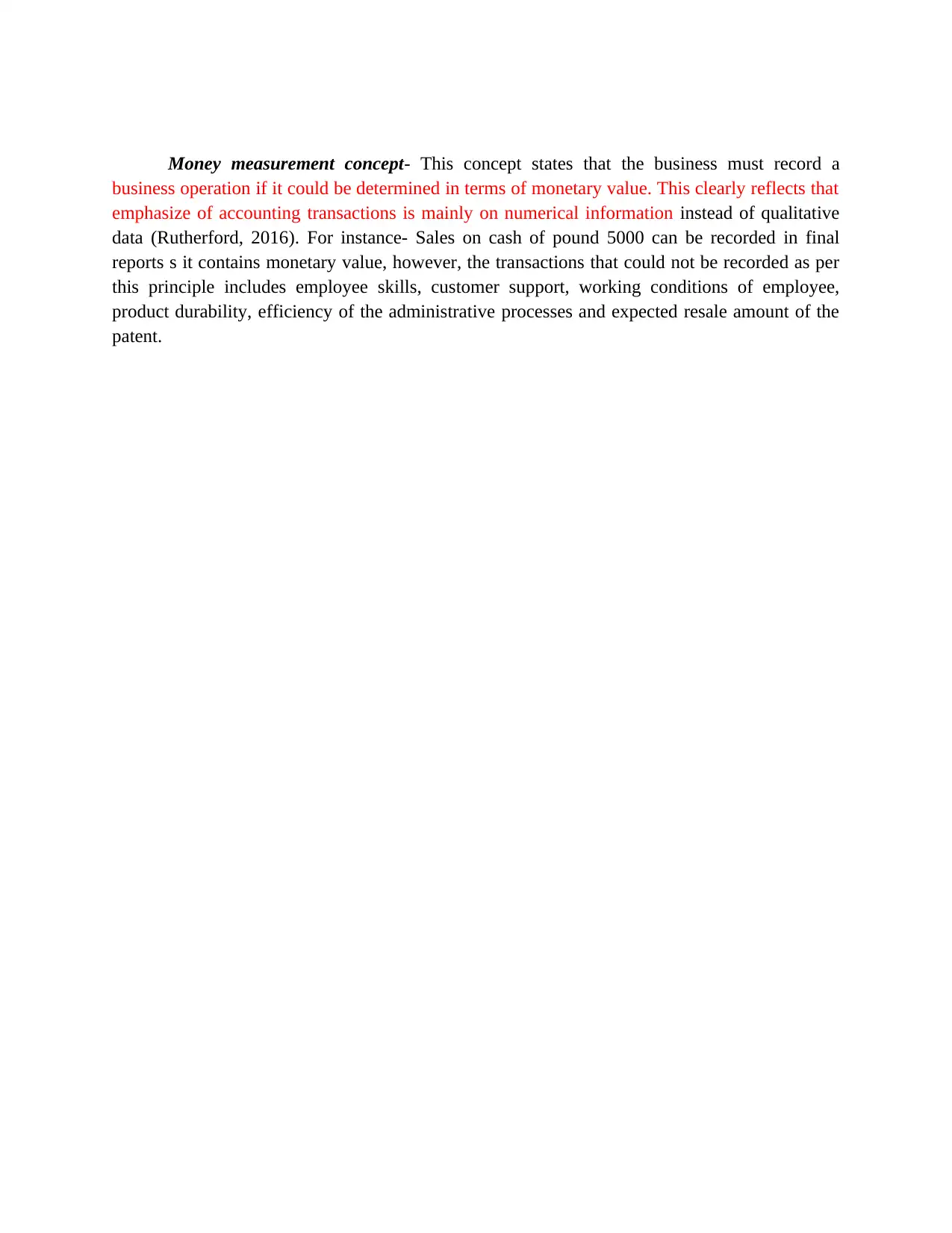
Money measurement concept- This concept states that the business must record a
business operation if it could be determined in terms of monetary value. This clearly reflects that
emphasize of accounting transactions is mainly on numerical information instead of qualitative
data (Rutherford, 2016). For instance- Sales on cash of pound 5000 can be recorded in final
reports s it contains monetary value, however, the transactions that could not be recorded as per
this principle includes employee skills, customer support, working conditions of employee,
product durability, efficiency of the administrative processes and expected resale amount of the
patent.
business operation if it could be determined in terms of monetary value. This clearly reflects that
emphasize of accounting transactions is mainly on numerical information instead of qualitative
data (Rutherford, 2016). For instance- Sales on cash of pound 5000 can be recorded in final
reports s it contains monetary value, however, the transactions that could not be recorded as per
this principle includes employee skills, customer support, working conditions of employee,
product durability, efficiency of the administrative processes and expected resale amount of the
patent.
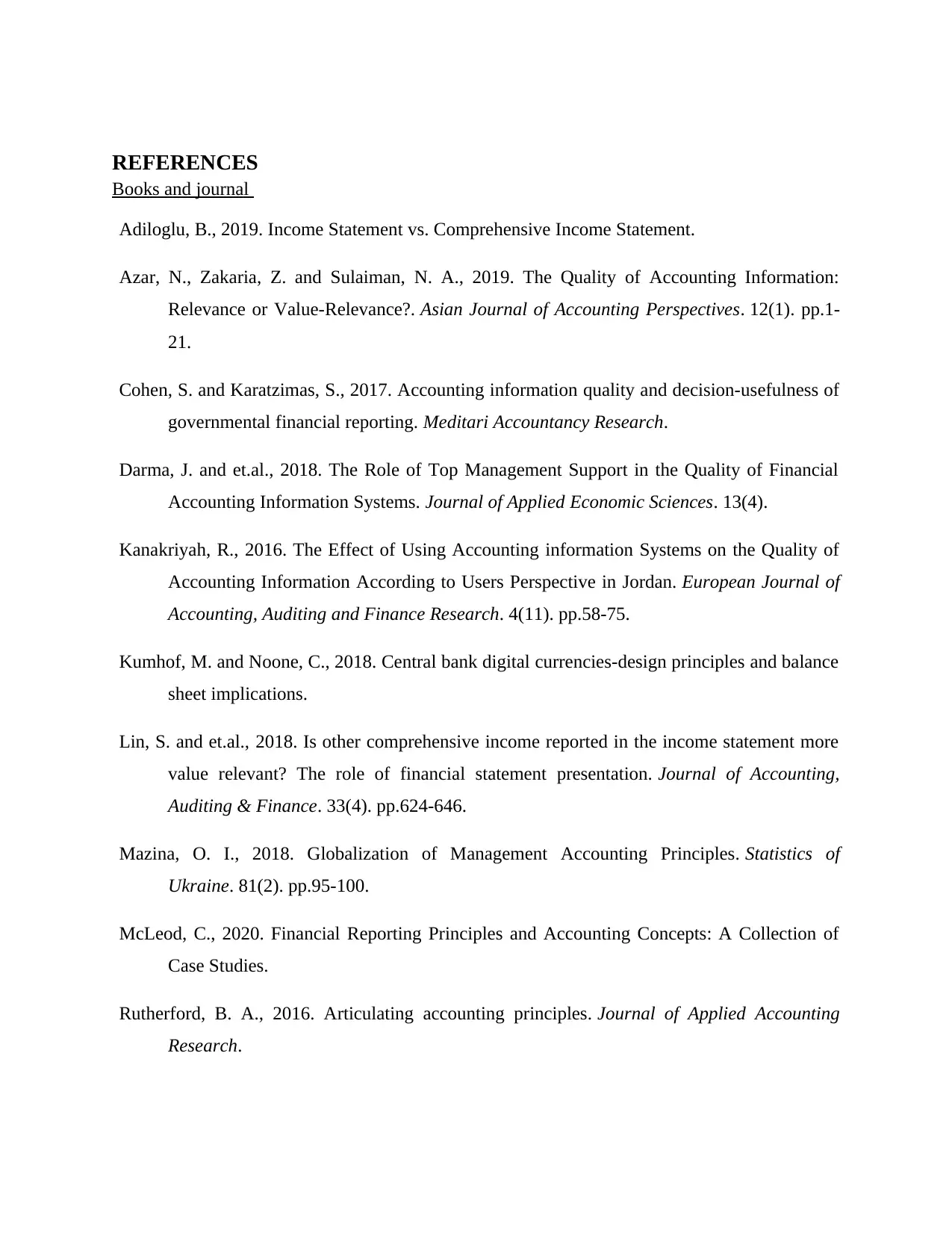
REFERENCES
Books and journal
Adiloglu, B., 2019. Income Statement vs. Comprehensive Income Statement.
Azar, N., Zakaria, Z. and Sulaiman, N. A., 2019. The Quality of Accounting Information:
Relevance or Value-Relevance?. Asian Journal of Accounting Perspectives. 12(1). pp.1-
21.
Cohen, S. and Karatzimas, S., 2017. Accounting information quality and decision-usefulness of
governmental financial reporting. Meditari Accountancy Research.
Darma, J. and et.al., 2018. The Role of Top Management Support in the Quality of Financial
Accounting Information Systems. Journal of Applied Economic Sciences. 13(4).
Kanakriyah, R., 2016. The Effect of Using Accounting information Systems on the Quality of
Accounting Information According to Users Perspective in Jordan. European Journal of
Accounting, Auditing and Finance Research. 4(11). pp.58-75.
Kumhof, M. and Noone, C., 2018. Central bank digital currencies-design principles and balance
sheet implications.
Lin, S. and et.al., 2018. Is other comprehensive income reported in the income statement more
value relevant? The role of financial statement presentation. Journal of Accounting,
Auditing & Finance. 33(4). pp.624-646.
Mazina, О. I., 2018. Globalization of Management Accounting Principles. Statistics of
Ukraine. 81(2). pp.95-100.
McLeod, C., 2020. Financial Reporting Principles and Accounting Concepts: A Collection of
Case Studies.
Rutherford, B. A., 2016. Articulating accounting principles. Journal of Applied Accounting
Research.
Books and journal
Adiloglu, B., 2019. Income Statement vs. Comprehensive Income Statement.
Azar, N., Zakaria, Z. and Sulaiman, N. A., 2019. The Quality of Accounting Information:
Relevance or Value-Relevance?. Asian Journal of Accounting Perspectives. 12(1). pp.1-
21.
Cohen, S. and Karatzimas, S., 2017. Accounting information quality and decision-usefulness of
governmental financial reporting. Meditari Accountancy Research.
Darma, J. and et.al., 2018. The Role of Top Management Support in the Quality of Financial
Accounting Information Systems. Journal of Applied Economic Sciences. 13(4).
Kanakriyah, R., 2016. The Effect of Using Accounting information Systems on the Quality of
Accounting Information According to Users Perspective in Jordan. European Journal of
Accounting, Auditing and Finance Research. 4(11). pp.58-75.
Kumhof, M. and Noone, C., 2018. Central bank digital currencies-design principles and balance
sheet implications.
Lin, S. and et.al., 2018. Is other comprehensive income reported in the income statement more
value relevant? The role of financial statement presentation. Journal of Accounting,
Auditing & Finance. 33(4). pp.624-646.
Mazina, О. I., 2018. Globalization of Management Accounting Principles. Statistics of
Ukraine. 81(2). pp.95-100.
McLeod, C., 2020. Financial Reporting Principles and Accounting Concepts: A Collection of
Case Studies.
Rutherford, B. A., 2016. Articulating accounting principles. Journal of Applied Accounting
Research.
Paraphrase This Document
Need a fresh take? Get an instant paraphrase of this document with our AI Paraphraser

van Helden, J. and Reichard, C., 2019. Making sense of the users of public sector accounting
information and their needs. Journal of Public Budgeting, Accounting & Financial
Management.
information and their needs. Journal of Public Budgeting, Accounting & Financial
Management.
1 out of 8
Related Documents
Your All-in-One AI-Powered Toolkit for Academic Success.
+13062052269
info@desklib.com
Available 24*7 on WhatsApp / Email
![[object Object]](/_next/static/media/star-bottom.7253800d.svg)
Unlock your academic potential
© 2024 | Zucol Services PVT LTD | All rights reserved.




